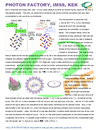issue contents
May 2006 issue

Cover illustration: The prism array X-ray lens clessidra developed at ELETTRA (Sincrotrone Trieste), see Jark, Pérennès and Matteucci, pages 239-252. Top: micrograph of the lens produced using deep X-ray lithography at the DXRL beamline at ELETTRA. The lens is made of pmma (polymethylmethacrylate = plexiglass) and consists of small prisms of height 25.67 µm and width 77.33 µm. The overall structure is 1.51 mm high, 2.6 mm wide and  0.65 mm deep. Bottom: radiographs taken 30 mm downstream of the lens during the tilt alignment with a photon energy of 10 keV (tilt increment 1°). A CCD camera with 3.85 µm equivalent pixel size was used at the SYRMEP beamline at ELETTRA at a source distance of 22.6 m. In this lens the resist thickness varied in the beam direction.
0.65 mm deep. Bottom: radiographs taken 30 mm downstream of the lens during the tilt alignment with a photon energy of 10 keV (tilt increment 1°). A CCD camera with 3.85 µm equivalent pixel size was used at the SYRMEP beamline at ELETTRA at a source distance of 22.6 m. In this lens the resist thickness varied in the beam direction.
facility information
research papers
 access
accessEvaluation of imaging performance of a taper optics CCD `FReLoN' camera designed for medical imaging
short communications
letters to the editor


book reviews

new commercial products

current events



 journal menu
journal menu





































